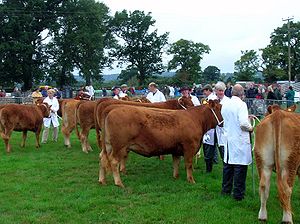- South Devon cattle
-
South Devon cattle, also known as Orange Elephants,[1] are the largest of the British Native breeds. They are believed to have descended from the large red cattle of Normandy which were imported during the Norman invasion of England. The breed is a rich, medium red with copper tints, though it varies in shade and can even appear slightly mottled. The breed today is predominately used for beef production although it has been milked in the past. The official governing body, The South Devon Herd Book Society was founded in 1891.
Contents
Breed history
The Early Years: It is believed South Devon cattle evolved from the large red cattle of Normandy which were imported to England at the time of the Norman invasion. The South Devon of today originated in South West England, in an area of Devon known as the South Hams from where they spread right across the counties of Devon and Cornwall. Historical evidence indicates that isolation caused the divergence of the North and South Devon into physically distinct types, though occasional crossing between the two breeds occurred until the mid-19th century.
The Breed in the 19th Century: The South Devon had been established as a Breed by the year 1800. With a light red coat, they were powerfully built and supplied rich milk and good beef, finely grained and marbled, and were relied upon to pull ploughshares until well into the 19th century. Careful selection of breeding stock improved the Breed considerably. The South Devon Herd Book Society was founded in 1891 when it was recognised by the Government as an official body, and the South Devons become one of the 14 breeds of cattle whose Herd Books date back to the second half of the 19th century.
The Breed in the 20th Century: During the early years of the 20th century the Breed was considered as dual purpose, for the production of milk and beef. Although most herds were milked during and soon after the Second World War the trend has been increasingly towards beefier sires since the 1960s. Although it is now a purely beef breed, the dual-purpose heritage has significance for the suckling of calves.
The Breed in the 21st Century: Recently, there have been attempts to re-introduce the breed into dairy farming. Taverner's Farm in Devon has a small herd which they use to produce their own brand of ice cream (Orange Elephant ice cream). They have attempted to produce a bull for this herd by artificial insemination of their aged prize heifer with 45-year old semen from the Rare Breeds Survival Trust's national genetic archive. As of August 2008, this has been unsuccessful after the calf was stillborn.[1][2]
Worldwide spread
The breed is exceptionally adaptable to varying climatic conditions and is presently well established on five continents. Wherever they have been introduced South Devon cattle have been well accepted and exhibited strong performance for production and profitability.
South Devons were one of the few British breeds to have been selected for drought purposes as well as for beef and milk. The first importations into Australia were of milking cows carried on sailing ships. Several large importations occurred in the late 19th and early 20th centuries but the breed then lost its identity through crossbreeding. Importations from Britain took place in 1969, and the first purebred animals were imported from New Zealand in 1971. The breed occurs in most states of Australia.
The first South Devons were taken to the United States in 1969, and in 1974 the North American South Devon Association was formed for the purpose of development, registration and promotion of the South Devon breed in that country.
Fast facts
- Known as "The Gentle Giants".[3]
- Females are early maturing and may be calved at 2 years of age (although 2.5 – 3 years is still common).
- Average gestation is 286 days.
- A dam can calve every year for as long as 15 years.
- Although primarily a beef breed, South Devons can be milked.
- Strong maternal instinct usually makes fostering fairly easy.
- Most births are single calves but twins do occur in approximately 10% of calvings.
- Bulls experience rapid growth, early maturity and can sire at around 15–18 months.
- Bulls can work up to the age of 12.
- A fully mature bull can weigh between 1,200 and 1,600 kg (2,600 and 3,500 lb), though the largest South Devon recorded has been weighed at 2,000 kg (4,400 lb).[4]
Agricultural shows
Pedigree South Devons can be seen exhibiting at the following Agricultural shows in 2007:
- Devon County Show 17–19 May
- Royal Cornwall Show 7 – 9 June
- The Royal Show 1 – 4 July
- Great Yorkshire Show 10 – 12 July
- Royal Welsh Show 23 – 26 July
In addition there will be South Devon classes at many one-day and county shows.
Breed success
The breed has enjoyed much success on the show circuit. The performance of the 85 entries at the 2005 Royal Cornwall were described by Farmers Weekly as "always a force, the South Devons were on world class form this year as the Royal Cornwall formed the launch pad to the South Devon World Association’s sixth World Congress." [5]
The South Devon Heard Book Society compiles a list of South Devon show results for the major events.
References
- ^ a b Jimmy Doherty's Farming Heroes: West of England episode, BBC2, broadcast 19th August 2008, [1]
- ^ Taverner's South Devon Herd
- ^ http://www.devoncountyshow.co.uk/viewnews.asp?id=385
- ^ http://203.99.65.121/author/story.cfm?a_id=203&objectid=10368970
- ^ South Devon rules in Cornwall - 14 June 2005 - FarmersWeekly
External links
Categories:- Cattle breeds originating in England
Wikimedia Foundation. 2010.



